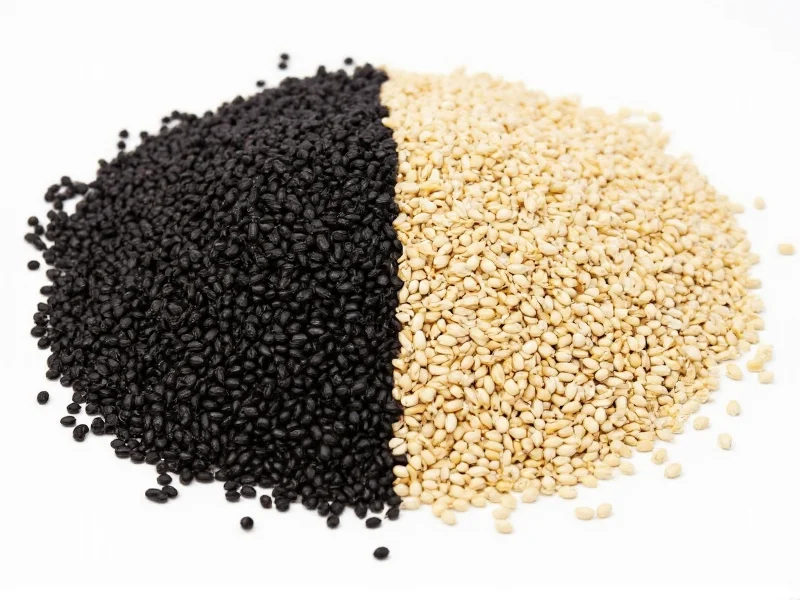Understanding Sesame Seed Varieties
When exploring the difference between black and white sesame seeds, it's essential to recognize that both varieties come from the same plant species (Sesamum indicum). The primary distinction lies in processing and the resulting nutritional and flavor characteristics. This comprehensive comparison will help you understand when to use each type for optimal culinary and health benefits.
Processing Differences: Hulling Explained
The most fundamental difference between black and white sesame seeds is the hulling process. White sesame seeds undergo a mechanical dehulling process where the outer seed coat is removed, revealing the pale inner kernel. Black sesame seeds retain their natural hull, which gives them their distinctive dark color.
This processing difference significantly impacts both nutritional content and culinary applications. The hull contains valuable nutrients that are lost when removed to create white sesame seeds. Understanding this black sesame vs white sesame nutritional comparison is crucial for making informed dietary choices.
Nutritional Profile Comparison
When examining the nutritional differences between black and white sesame seeds, several key distinctions emerge. Black sesame seeds generally contain higher levels of certain minerals and antioxidants due to the retained hull.
| Nutrient (per 1 oz/28g) | Black Sesame Seeds | White Sesame Seeds |
|---|---|---|
| Calories | 160 | 160 |
| Calcium | 14% DV | 9% DV |
| Iron | 16% DV | 14% DV |
| Magnesium | 22% DV | 20% DV |
| Zinc | 13% DV | 11% DV |
| Antioxidants | High (sesamol, sesamin) | Moderate |
The black sesame seeds nutritional benefits include higher concentrations of sesamol and other antioxidants found in the hull. These compounds contribute to the seeds' stronger flavor profile and potential health benefits. White sesame seeds, while still nutritious, lose some of these compounds during the hulling process.
Flavor and Texture Characteristics
When comparing black sesame vs white sesame taste, the differences are quite pronounced. Black sesame seeds deliver a more robust, earthy, and slightly bitter flavor with intense nuttiness. White sesame seeds offer a milder, sweeter, and more delicate nutty flavor that's less assertive in dishes.
Texture-wise, both varieties have similar crunch when raw, but black sesame seeds maintain more structural integrity when cooked due to their intact hulls. This makes them particularly valuable in certain culinary applications where texture matters.
Culinary Applications and Pairings
Understanding the culinary differences between black and white sesame seeds helps determine which to use in specific recipes:
- White sesame seeds: Ideal for making tahini, incorporated into baked goods, sprinkled on salads, or used in Western-style dishes where a subtle nutty flavor is desired
- Black sesame seeds: Preferred in Asian cuisine for fillings, pastes, noodles, and desserts where their dramatic color and stronger flavor enhance the dish
Professional chefs often consider the black sesame seeds vs white sesame seeds visual impact when plating dishes. Black seeds create striking contrast against light-colored foods, while white seeds blend more subtly into many preparations.
Health Benefits Comparison
Both varieties offer significant health benefits, but there are notable differences in their black and white sesame seeds health properties:
Black sesame seeds contain higher levels of anthocyanins (the same antioxidants found in blueberries) due to their dark hulls. These compounds provide additional anti-inflammatory benefits. The intact hull also means black sesame seeds generally have slightly higher fiber content.
White sesame seeds remain an excellent source of healthy fats, protein, and minerals, making them valuable for bone health, heart health, and blood sugar regulation. When evaluating which sesame seeds are healthier black or white, the answer depends on specific nutritional priorities.
Storage and Shelf Life Considerations
Due to their intact hulls, black sesame seeds typically have a longer shelf life than white sesame seeds. The hull provides natural protection against oxidation. Properly stored in an airtight container:
- Black sesame seeds: 12-18 months at room temperature, up to 2 years refrigerated
- White sesame seeds: 6-12 months at room temperature, up to 1 year refrigerated
For maximum freshness and to preserve the nutritional value of black and white sesame seeds, store both varieties in the refrigerator or freezer, especially in warm climates.
Substitution Guidance
When considering can I substitute black sesame seeds for white (or vice versa), several factors come into play:
- For visual dishes: Substitution may dramatically alter appearance
- For flavor-sensitive recipes: Black seeds will impart stronger flavor
- For nutritional purposes: Black seeds generally offer slightly higher nutrient density
In most savory applications, you can substitute one for the other at a 1:1 ratio, but be prepared for flavor and color differences. For baking, white sesame seeds are generally preferred as black seeds can discolor light-colored doughs.
Traditional and Cultural Uses
The cultural differences between black and white sesame seeds reveal interesting regional preferences:
- East Asian cuisine: Black sesame seeds feature prominently in Chinese, Japanese, and Korean desserts, pastes, and rice dishes
- Middle Eastern cuisine: White sesame seeds dominate in tahini, halva, and various breads
- Indian cuisine: Both varieties appear, with white more common in northern dishes and black in some southern specialties
Understanding these traditional uses can guide your selection when preparing authentic regional dishes and help you appreciate the historical significance of black and white sesame seeds.











 浙公网安备
33010002000092号
浙公网安备
33010002000092号 浙B2-20120091-4
浙B2-20120091-4